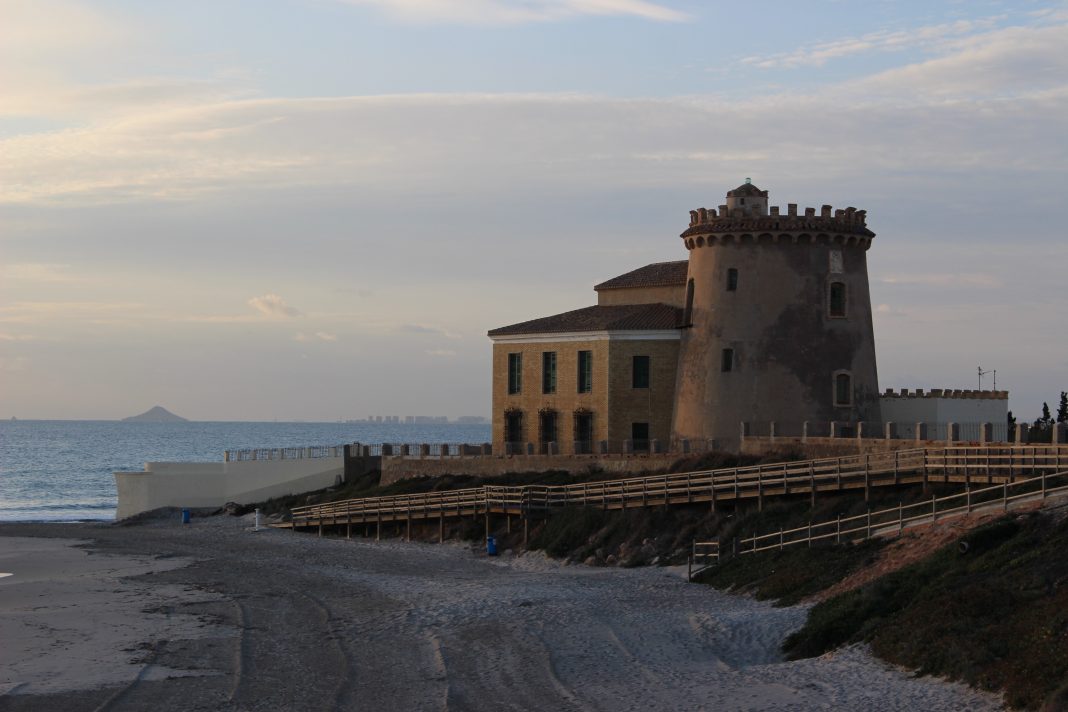The most valued historical heritage maintained by Pilar de la Horadada remains under lock and key where, despite a legal obligation to open to the public on four occasions every month, the owners refuse to open the doors.
The situation is reminiscent of what happened in the Pazo de Meirás de los Franco, General Franco’s Summer Manor hours in Galicia, where the building was eventually opened after many years, despite the opposition of it’s owners.
At the present time the watchtower can only be seen from the outside and very few members of the public have had the privilege of finding out just what is hidden within its walls.
It was built in 1591 as one of Felipe II fortifications of the Kingdom of Valencia for the defence of the inhabitants of what was then Campo de la Horadada against the attacks of the Berber pirates right up until the end of the 19th century when it was sold at public auction to the Count of Roche.
In recent years the tower has been awarded the status of item of cultural interest and as such, in accordance with the Law of Valencian Heritage, it must open to the public at least four times a month. But the family that holds the noble title today has so far refused as a result of which its contents remain a closely guarded secret.
Meanwhile, the authorities grow increasingly concerned at its deterioration, both the internal residence and the tower which have formed an important part of the municipality’s history for many years, and that today represent a hallmark which they are not willing to give up.
The Watch tower and the house extension are located on an imposing estate overlooking the Mediterranean Sea. They even have a private staircase that gives access to the beach.
The tower itself has a ground floor, two further floors and a terrace with a security gate. The overall aspect of this plot is one of absolute decadence although its green wooden windows are rickety and the heraldic shield shows obvious signs of deterioration.
The metal fence that borders the plot it is old and rusty. The wall that holds it, cracked and with many holes. Of the once magnificent gardens only wild stubble remains and a number of neglected palm trees.
The paint on the walled courtyard is peeling. The access doors are closed, the bell does not work and there is only one suggestion that would make one think that someone lives there: a television aerial.
Local residents say that for most of the year nobody lives in the house and the owners only visit for a few weeks in summer but despite its status, the tower has been registered in the General Registry of Real Estate of Cultural Interest of the Spanish Historical Heritage since 1995.
The General Directorate of Culture and Heritage of the Generalitat admits that descendants of the lineage are blocking the access of government surveyors who must urgently assess the state of the tower to determine if it needs strengthening or restoration works that will guarantee its conservation status. However, according to the local administration, the request for access was made four months ago, but the watch tower remains closed.
The watchtower was last inspected by officials in March 2016 but two years have since passed and nobody has been able to gain re-entry.
The director of Culture in the municipality, María García, is one of the few people who had the privilege of accessing the property on one occasion, but that was back in 1996 during one of the inspections. Since then she has not returned.
So in the last two years no one knows if any work has been done inside the building. The only thing that the Generalitat is clear about is that since 2016 they have authorized no work to be carried out either in the tower or in the annexed house. “We simply don’t know if any work has been carried out in the last two years, when the last inspection was made,” a spokesman of the Generalitat confirmed.
The Municipal Councilor for Culture, Maria Trinidad Escarabajal, says that despite them violating the law that requires entry to the public, the owners still enjoy important tax privileges. They do not pay Real Property Tax (IBI) for the site because it is an Asset of Cultural Interest. In this regard, the councillor says that “they are accepting all the privileges but avoiding their obligations.”
Escarabajal explained that on several occasions attempts have been made to negotiate with the owners to bring the plot back to life for public use. She said that the town is even willing to finance the refurbishments that are needed in exchange for access by visitors to the watchtower.
“The gardens could also be restored with a view toward holding cultural events in them,” she adds. This is also supported by local residents who, through a collective, have been collecting signatures for months to gain access to this heritage site under the Valencian legislation.
But for now, it will remain a forbidden tower, although the end of the story is still to be written.





